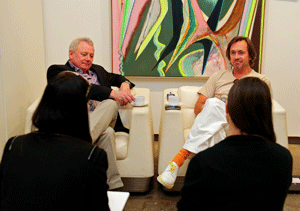Marc Newson and Caroma talk style in the bathroom

Highly acclaimed contemporary designer Marc Newson has collaborated with popular Australian bathroom brand Caroma, to bring a modern and streamlined edge to the bathroom. Newson’s infamous retro-futuristic style is coupled with Caroma’s clever engineering to create products that are simple in design yet extremely complex in function, and will bring the wow factor to any bathroom.
The Caroma Marc Newson collection has a minimalistic look for baths, showers, toilets and taps and even incorporates pops of orange colour. Newson has blended the elements of engineering, art and functionality seamlessly, resulting in a range that is bound to remain universal and timeless.
Alex Longstaff, our Features Editor at Luxury Home Design magazine, had the opportunity to catch up with Marc Newson and Neil Evans, CEO of GWA Bathrooms and Kitchens to discuss the collection and get some inside gossip into how Marc Newson’s brain ticks.
When you were young, did you ever foresee an acknowledgement of your work like Time Magazine’s ‘100 Most Influential People in the World’?
Marc: No, I didn’t really foresee that. I didn’t foresee myself being a designer; I didn’t really know that that profession existed until I was in my teens.
So what sparked that in your teenage years?
Marc: I liked to make things; I liked inventing things and building things really. Essentially, I liked having things. I guess had I had the money as a child, I would have been able to go out and buy them, but I didn’t, so I was kind of driven by necessity.
Who or what influences your work?
Marc: With this range, I think my inspiration was really, as it is for many other things, just simply looking at what exists or doesn’t exist in the market and ultimately what I’d go and spend my money on. What I’d put in my own bathroom, because, you know I’ve designed plenty of bathrooms and have been in a position, on a number of occasions, where I’ve had to specify this stuff, not only for me personally but in jobs that I’ve done. So I know from a consumer’s perspective what I’d like to see and I’ve had the opportunity to think about that over a number of years, so it’s great to be given the opportunity to answer some of those questions – you know, put your money where your mouth is!
If you had to choose three words to describe your approach to design, what would they be?
Marc: Modern, accessible, Australian.
What was the impetus and goal for this Caroma project?
Neil: It was three things. We wanted to do a bathroom range with all of the major pieces launched at one time. So this collection has 23 pieces that we’re launching. No one in Australia had attempted to have one designer do a whole bathroom collection and launch in one year.
Secondly, we wanted it to be accessible. We wanted really good design to be accessible to the general market; we didn’t want it to be super expensive. And finally, we were looking for a designer who could really capture the essence of the Caroma brand and bring that to life and extend our thinking. And there was really only one person who fitted that brief and that was Marc. So there was no plan B if Marc wasn’t interested.
Marc: I think it also had to be someone from Australia, someone that knew the brand. You know, I grew up with the brand, like everyone in Australia, so I’m really intimately familiar with the product and personality of the brand.
Neil: So with an iconic Australian bathroom brand and Australia’s most famous designer, it was just a perfect match.
What elements of this new range are you most excited about?
Marc: It’s very hard to identify particular things. I mean as a range, that was the most exciting thing, that there was such a comprehensive range of products; we really didn’t leave any stone unturned, even down to the plugs, the attention to detail is just like no other anywhere in the world. From an engineering perspective, it is really unique.
Neil: Plus a real labour of love from our people, there is an enormous amount of work; our people have gone above and beyond normal to make it happen.
Marc: We set some pretty exciting challenges for ourselves with the engineering, the stuff that no one will see – the way the tap works, the way that it’s plumbed, you know it’s incredibly complex.
Neil: The engineering behind it is phenomenal, it’s worth seeing the installation video and we make sure we follow it all the way through even to the plumber that has to install it. And the other thing was the timeline. It’s a phenomenally short timeline in this industry to bring 23 pieces together.
When I look at your design history, I see a lot of bridging between the art world, the industrial/engineering world, and also a sort of extra-terrestrial theme. Are there elements of these ideals in your work with Caroma?
Marc: It’s hard for me to see exactly what it is that comes through. It’s modern, it needs to be modern and, for me, it’s a bit like having to look into a crystal ball. The process takes some years and it will take a few more years for the product to bleed into the marketplace and to start seeing it around and that whole process can take five to 10 years; not because the product isn’t accepted, it just takes time for the product to become completely ubiquitous. The job of the designer is to try to imagine what it is going to look good in five years.
You have to be confident that it’s going to work and that it won’t be out of date before it comes out; so modern is what we aspired to.
Material is obviously key to design in general and key to your approach when offered a project. I’ve noticed the challenge of designing something in a manner that is a problem needing to be solved as well as one that pushes boundaries is pivotal to your designs. Does material steer the direction of your design, or does the design choose the material?
Marc: A little bit of both but I think, in this case, given that the materials that you use tend to be quite familiar, I’m talking about ceramics and brassware and things like that. First, you’ve got to understand what the materials can do and their limitations and how far you can push them. But for me, it’s steered more by what’s not in the market, looking for those holes and trying to plug the gap.
You’ve mentioned that mass production is the ultimate goal for a designer. Good quality design that appeals and works for the large majority of the public. There is obviously a degree of sustainable thinking in this ethos. Does sustainability feature highly when it comes to your designs?
Marc: Whether something is mass produced, or you only produce a few, in relation to environmental issues, the most important thing for me is not designing disposable products. I like the idea of designing really good products. People can buy this stuff and it should work for the rest of their life, and that’s a great thing. Neither of us is in the business of designing landfill and ultimately, for me, that’s the most environmentally responsible attitude to have as a designer.
You grew up in Sydney, and now live between London and Paris. What would you say are the greatest differences between trends in Europe and Australia − particularly in the sphere of home design and the bathroom?
Marc: The world is becoming such a small place. Design is such an international industry, there’s nothing really geographical specific about it. This collection was made by an Australian company for an Australian market, but having said that, they would be just as appropriate in America or Europe, China or South America, and they would look just as good and just as modern.
You’ve dabbled in so many areas of design, and clearly learnt from each experience. What would you say the most valuable lessons you’ve taken from your time would be?
Marc: What I have understood and learnt in this particular case was how streamlined the process can be…
Neil: Working with Marc, we wanted to bring to life his ideas and to produce a great body of work. Like with some of the little things that we didn’t think of, for example the ceramic buttons on the toilet; these seem pretty obvious but no one has ever thought of that before.
Marc: There has been a real sense of optimism surrounding this collaboration, which is really encouraging, especially in the context of the world in which we are living in right now.
For more information:
Caroma Marc Newson
Web: www.caromamarcnewson.com
The Charles Grand Brasserie & Bar is the latest hospitality venture to blend old-world opulence with contemporary flair, ...
Creative director Jacu Strauss has partnered with vintage marketplace Vinterior to create four themed suites at London’s Sea ...
Coles is reinforcing its influence on Australia’s urban landscape, anchoring two major mixed-use residential developments in Melbourne and ...
As open-plan offices dominate the modern workplace, the demand for quieter, more focused environments is rising. Berlin Acoustics, founded ...
Sydney Build, Australia’s largest construction and design show, opens doors at 9am on May 7th and 8th, at ...








